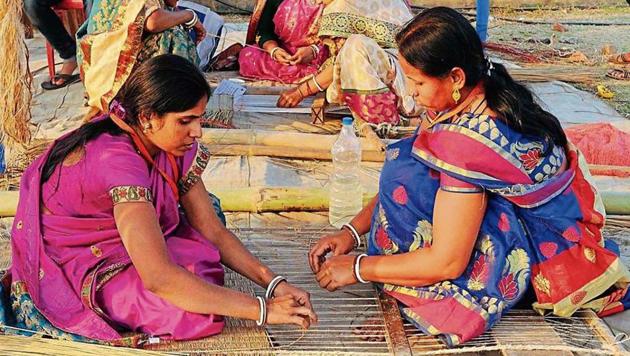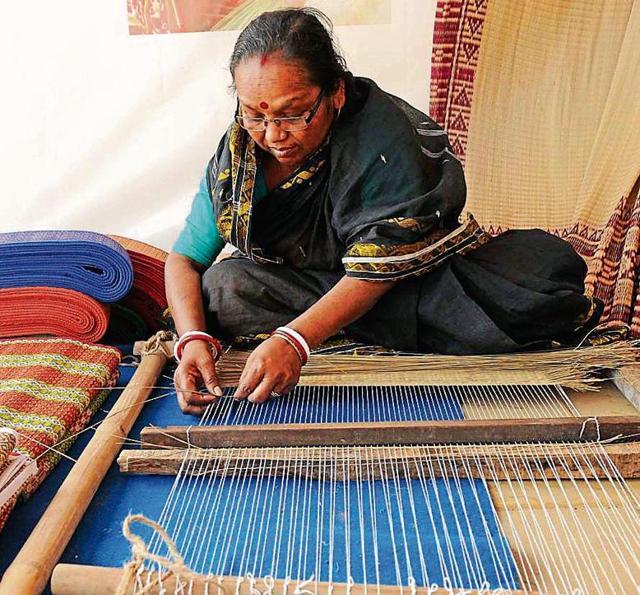Reweaving economy: Fairs bring to life Bengal’s folk art forms, empower craftsmen
West Bengal govt’s much ridiculed emphasis on fairs and festivals has helped revive dying folk art forms, besides helping rural craftsmen earn more.
Sarajubala Giri, 59, who received a medal from the President of India R Venkataraman in 1989 for excellence in straw mat weaving, witnessed traditional mat weavers in East Midnapore district quitting the profession one after another, until the tide started turning about five years ago.

Basudeb Bhalla, Raibeshe dancer from Murshidabad district, saw troupes getting defunct as there were not enough shows for teams to survive, until there was a sudden increase in demand.
Mohanlal Bairagi, a puppeteer from Nadia district, had been sinking in despair because puppetry was turning into a thing of the past, until a sudden increase in number of fairs and festivals brought a ray of hope.
They were all attending the first edition of Madur Mela, dedicated to mat weavers, held on Digha sea beach . This is one of the newest entries to Bengal’s list of fairs and festivals that have increased during the Mamata Banerjee regime. While the government’s increased spending on fairs and festivals drew flak from opposition parties, who called the government ‘Mela-mochchhober Sarkar’ or a government for fairs and festivals, the likes of Giri, Bhalla and Bairagi have another tale to tell.
“The situation has changed over the past five-six years. With number of fairs and festivals held across the state sharply increasing our sales and workload have suddenly increased. So has the number of weavers,” Giri said.
Back to work
This is the story of a turnaround. Less than a decade ago, these traditional art and craft forms — from jhumur dance, natua dance, wooden mask making, wooden doll making, patachitra or scroll painting, sitalpati or cool mat weaving to dokra jewellery and home decor and bhawaia songs — found references in news articles as the new generations of artistes and craftsmen were joining other professions. But no more. Number of rural craftsmen and folk artists has rapidly increased in Bengal over the past five years. The reason: while the government has introduced new fairs, inspired by the CM, Trinamool leaders in different districts, too, have started patronising new fairs at the local level.
Take the words of Biren Kalindi, the head of a Natua dance team at Balarampur in Purulia district, for example. Natua is an ancient dance form that has martial origins and was on the verge of extinction. “There are only four Natua teams in Purulia that perform professionally. Even these groups were struggling until five years ago. But the number of shows we used to get has more than doubled over the past five years.”

According to Binadhar Kumar, a sexagenarian chhou dance guru from Bamnia in Purulia district, “About five years ago, no village had more than one chhou team. Now there are several villages having two-three chhou teams. This has also helped increase the sales of chhou mask and the craftsmen are witnessing better days as well.”
There used to be fewer than 100 chhou troupes before 2011 and the number was dwindling. It, however, reached close to 300 by the end of 2016. Kumar’s team performed more than 135 shows in 2016, whereas they used to get between 60 and 70 shows a year during 2010-2011.
Full calendar
Among the dozens of new festivals and fairs started during the Trinamool regime are Mati Utsav, Jangalmahal Utsav, Baul Utsav, Uttarbanga Utsav, Vivek Utsav. Among fairs being introducing this year are mat fair at Sabang and Digha in West and East Midnapore districts, respectively, Bhawaia (song) fair at Alipurduar, Darjeeling Utsav focusing on folk art and crafts of the hill region, Sunderbans Utsav highlighting the art and crafts of the region and Jhargram Utsav to promote products made of saal leaves and sabai grass.
Mamata Banerjee seemed to have been confident about the benefits of spending on fairs right from the beginning. In January 2013, when former chief minister and CPI(M) politburo member Buddhadeb Bhattacharjee ridiculed the government for ‘unnecessary spending on fairs and festivals’, Banerjee had shot back at Bhattacharjee, saying, “Festivals also boost the economy of the state as many people come to them to sell their products.”
Later in the same year, her government joined hands with UNESCO to set up 10 rural craft hubs in 10 districts, involving 3,000 rural craftsmen. After receiving UNESCO’s praises in 2016, the project was expanded to 15 districts as Rural Crafts and Culture Hubs, involving 15,000 artists and craftsmen.
In these hubs, artistes and craftsmen are trained to make diversified products to meet the demands of the contemporary market. Government has also built accommodation facilities for cultural tourism.
“Between April 2015 and December 2016, the 3,000 artists involved the 10 rural craft hubs sold products worth Rs 14 crore,” said Amitava Bhattacharya, director of Banglanatak dot com, a social enterprise which is the implementing agency for the project. Baul-fakirs of Birbhum and Nadia and Bhawaia singers of north Bengal are faring better as well.
Most of the artistes, craftsmen live in poverty and are from marginalised communities. The artists said the average income has increased by nearly 50%, at one some occasions doubled, over the past five years.
“Who cared for the makers of rope from Babui ghas (a type of weed)? At one time, Maoists organised the people like us to demand basic human dignity and hike wages. And now, during the Mamata Banerjee regime, we are being treated as artistes,” said Menoka Mahato from Jhargram, West Midnapore.




